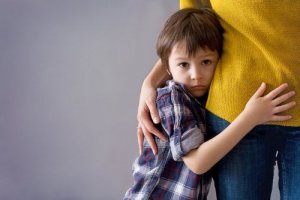5 Tips for Protecting Children's Privacy

Protecting your children is getting more and more complicated. New technologies make children more vulnerable to dangerous situations. That’s why it’s so important to have effective strategies and practices for protecting children’s privacy and innocence.
The importance of protecting children’s privacy
Children’s innocent and trusting nature has always made them more vulnerable to dangerous situations. When you add all the new technologies to that vulnerability, it makes it especially easy for ill-intentioned people to do harm.
Parents are responsible for not only protecting their children but also for teaching them to protect themselves. Protecting children’s privacy and innocence is one of the most important and transcendental jobs you have as a parent.
Tips for protecting children’s privacy
Teach them how to use the internet correctly
The internet has become one of the most dangerous tools that children have access to. That’s because children tend to trust what they read and see (not unlike many adults). So, it’s vitally important that you talk with your child often about how to safely use the internet and why it can be dangerous.
In addition to talking to your children, teach them how to correctly use these modern digital tools. How? Keep reading…

Show your child how to use the privacy settings on social media platforms, and how to block certain web pages on different devices. Always keep tabs on what your child is looking at when they surf the internet. There’s so much content out there and it’s very easy for children to innocently click on something that could be harmful.
Never share personal information
One of the most important things you can do to protect you children’s privacy is to teach them never to share personal information with anyone. Children must understand that under no circumstances are they to share information about their address, school, parent’s place of work, last names, phone numbers, etc.
Tell your children to be especially careful when using social media. On these platforms, it’s easy to give away personal information without even realizing it. If your children post a picture of themselves in their uniform, for example, anyone who sees it will know where they go to school. Or they might post a photo of the street they live on, which can be revealing if the street has some unique characteristics.
Teach your children to err on the side of caution. The best rule of thumb is not to share any personal photos or personal information on social media where it will be on display for all the world to see.
“Parents are responsible for not only protecting their children but also for teaching them to protect themselves.”
Other tips for protecting children’s privacy
Don’t kiss children on the lips
Many parents kiss their children on the lips. While it’s usually a perfectly innocent practice, it’s better not to do it, especially as children grow.
Teach children from a very young age that no one should kiss them on the mouth, even family or friends. Sitting on other people’s laps should also be off-limits.
Tell them that it’s not okay for people to touch them
Start teaching your children to wash their own genitals from a very young age. You also need to help them understand who can touch them and who can’t. They should be able to trust you completely so that if something bad happens, they feel that they can tell you.
Pay close attention to your children’s behavior and any changes they’re experiencing. If they seem uncomfortable in certain people’s presence or in certain situations, that could be cause for alarm.

Watch your children when they’re playing with other kids
Unfortunately, sometimes children abuse other children. That’s why it’s so important for parents to be alert and watchful when their sons and daughters play with other children.
While you can’t control what other children do at home, you can keep an eye on your own. Games such as “house” or “mommy and daddy” often lead to inappropriate behavior in young children.
We recommend that parents put these tips into practice to protect children’s privacy and innocence. Constant communication with your children and active, watchful parenting are key to keeping your kids safe and happy.
Protecting your children is getting more and more complicated. New technologies make children more vulnerable to dangerous situations. That’s why it’s so important to have effective strategies and practices for protecting children’s privacy and innocence.
The importance of protecting children’s privacy
Children’s innocent and trusting nature has always made them more vulnerable to dangerous situations. When you add all the new technologies to that vulnerability, it makes it especially easy for ill-intentioned people to do harm.
Parents are responsible for not only protecting their children but also for teaching them to protect themselves. Protecting children’s privacy and innocence is one of the most important and transcendental jobs you have as a parent.
Tips for protecting children’s privacy
Teach them how to use the internet correctly
The internet has become one of the most dangerous tools that children have access to. That’s because children tend to trust what they read and see (not unlike many adults). So, it’s vitally important that you talk with your child often about how to safely use the internet and why it can be dangerous.
In addition to talking to your children, teach them how to correctly use these modern digital tools. How? Keep reading…

Show your child how to use the privacy settings on social media platforms, and how to block certain web pages on different devices. Always keep tabs on what your child is looking at when they surf the internet. There’s so much content out there and it’s very easy for children to innocently click on something that could be harmful.
Never share personal information
One of the most important things you can do to protect you children’s privacy is to teach them never to share personal information with anyone. Children must understand that under no circumstances are they to share information about their address, school, parent’s place of work, last names, phone numbers, etc.
Tell your children to be especially careful when using social media. On these platforms, it’s easy to give away personal information without even realizing it. If your children post a picture of themselves in their uniform, for example, anyone who sees it will know where they go to school. Or they might post a photo of the street they live on, which can be revealing if the street has some unique characteristics.
Teach your children to err on the side of caution. The best rule of thumb is not to share any personal photos or personal information on social media where it will be on display for all the world to see.
“Parents are responsible for not only protecting their children but also for teaching them to protect themselves.”
Other tips for protecting children’s privacy
Don’t kiss children on the lips
Many parents kiss their children on the lips. While it’s usually a perfectly innocent practice, it’s better not to do it, especially as children grow.
Teach children from a very young age that no one should kiss them on the mouth, even family or friends. Sitting on other people’s laps should also be off-limits.
Tell them that it’s not okay for people to touch them
Start teaching your children to wash their own genitals from a very young age. You also need to help them understand who can touch them and who can’t. They should be able to trust you completely so that if something bad happens, they feel that they can tell you.
Pay close attention to your children’s behavior and any changes they’re experiencing. If they seem uncomfortable in certain people’s presence or in certain situations, that could be cause for alarm.

Watch your children when they’re playing with other kids
Unfortunately, sometimes children abuse other children. That’s why it’s so important for parents to be alert and watchful when their sons and daughters play with other children.
While you can’t control what other children do at home, you can keep an eye on your own. Games such as “house” or “mommy and daddy” often lead to inappropriate behavior in young children.
We recommend that parents put these tips into practice to protect children’s privacy and innocence. Constant communication with your children and active, watchful parenting are key to keeping your kids safe and happy.
All cited sources were thoroughly reviewed by our team to ensure their quality, reliability, currency, and validity. The bibliography of this article was considered reliable and of academic or scientific accuracy.
- DE, D. (2006). Infancia y adolescencia. In Índice del Especial: XXII Congreso Español de Pediatría Social (p. 33). http://retjapan.org/wp-content/uploads/2015/07/RET_COL_Derechos_de_infancia_y_adolescencia_2013.pdf
- No, L. E. Y., Doctor, P. C. N., Martínez, J. M., & Director, S. (97). Código de la Niñez y la Adolescencia. http://iin.oea.org/PatriaPotestad/Codigos/Cod.Niñez/Cod.%20Niñez%20y%20Adolescencia%20Ecuador.pdf
This text is provided for informational purposes only and does not replace consultation with a professional. If in doubt, consult your specialist.








